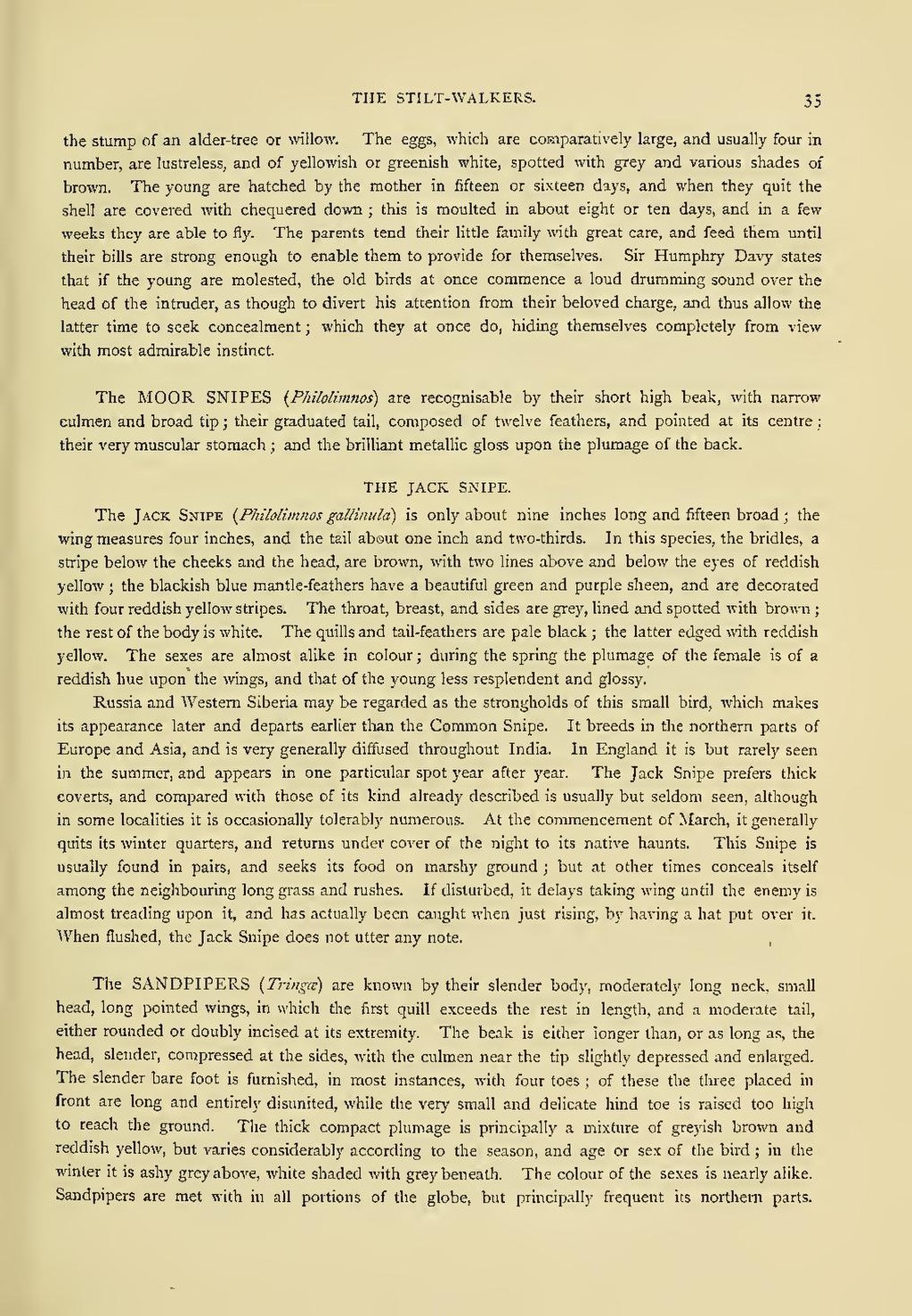the stump of an alder-tree or willow. The eggs, which are comparatively large, and usually four in number, are lustreless, and of yellowish or greenish white, spotted with grey and various shades of brown. The young are hatched by the mother in fifteen or sixteen days, and when they quit the shell are covered with chequered down; this is moulted in about eight or ten days, and in a few weeks they are able to fly. The parents tend their little family with great care, and feed them until their bills are strong enough to enable them to provide for themselves. Sir Humphry Davy states that if the young are molested, the old birds at once commence a loud drumming sound over the head of the intruder, as though to divert his attention from their beloved charge, and thus allow the latter time to seek concealment; which they at once do, hiding themselves completely from view with most admirable instinct.
The MOOR SNIPES (Philolimnos) are recognisable by their short high beak, with narrow culmen and broad tip; their graduated tail, composed of twelve feathers, and pointed at its centre; their very muscular stomach; and the brilliant metallic gloss upon the plumage of the back.
THE JACK SNIPE.
The Jack Snipe (Philolimnos gallinula) is only about nine inches long and fifteen broad; the wing measures four inches, and the tail about one inch and two-thirds. In this species, the bridles, a stripe below the cheeks and the head, are brown, with two lines above and below the eyes of reddish yellow; the blackish blue mantle-feathers have a beautiful green and purple sheen, and are decorated with four reddish yellow stripes. The throat, breast, and sides are grey, lined and spotted with brown; the rest of the body is white. The quills and tail-feathers are pale black; the latter edged with reddish yellow. The sexes are almost alike in colour; during the spring the plumage of the female is of a reddish hue upon the wings, and that of the young less resplendent and glossy.
Russia and Western Siberia may be regarded as the strongholds of this small bird, which makes its appearance later and departs earlier than the Common Snipe. It breeds in the northern parts of Europe and Asia, and is very generally diffused throughout India. In England it is but rarely seen in the summer, and appears in one particular spot year after year. The Jack Snipe prefers thick coverts, and compared with those of its kind already described is usually but seldom seen, although in some localities it is occasionally tolerably numerous. At the commencement of March, it generally quits its winter quarters, and returns under cover of the night to its native haunts. This Snipe is usually found in pairs, and seeks its food on marshy ground; but at other times conceals itself among the neighbouring long grass and rushes. If disturbed, it delays taking wing until the enemy is almost treading upon it, and has actually been caught when just rising, by having a hat put over it. When flushed, the Jack Snipe does not utter any note.
The SANDPIPERS (Tringæ) are known by their slender body, moderately long neck, small head, long pointed wings, in which the first quill exceeds the rest in length, and a moderate tail, either rounded or doubly incised at its extremity. The beak is either longer than, or as long as, the head, slender, compressed at the sides, with the culmen near the tip slightly depressed and enlarged. The slender bare foot is furnished, in most instances, with four toes; of these the three placed in front are long and entirely disunited, while the very small and delicate hind toe is raised too high to reach the ground. The thick compact plumage is principally a mixture of greyish brown and reddish yellow, but varies considerably according to the season, and age or sex of the bird; in the winter it is ashy grey above, white shaded with grey beneath. The colour of the sexes is nearly alike. Sandpipers are met with in all portions of the globe, but principally frequent its northern parts.
